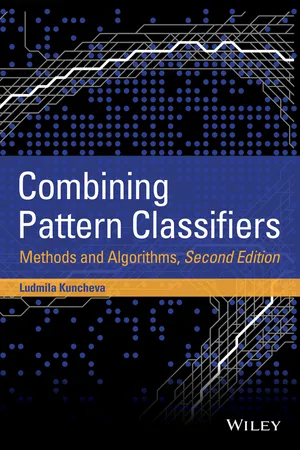
- English
- ePUB (mobile friendly)
- Available on iOS & Android
About this book
A unified, coherent treatment of current classifier ensemble methods, from fundamentals of pattern recognition to ensemble feature selection, now in its second edition
The art and science of combining pattern classifiers has flourished into a prolific discipline since the first edition of Combining Pattern Classifiers was published in 2004. Dr. Kuncheva has plucked from the rich landscape of recent classifier ensemble literature the topics, methods, and algorithms that will guide the reader toward a deeper understanding of the fundamentals, design, and applications of classifier ensemble methods.
Thoroughly updated, with MATLAB® code and practice data sets throughout, Combining Pattern Classifiers includes:
- Coverage of Bayes decision theory and experimental comparison of classifiers
- Essential ensemble methods such as Bagging, Random forest, AdaBoost, Random subspace, Rotation forest, Random oracle, and Error Correcting Output Code, among others
- Chapters on classifier selection, diversity, and ensemble feature selection
With firm grounding in the fundamentals of pattern recognition, and featuring more than 140 illustrations, Combining Pattern Classifiers, Second Edition is a valuable reference for postgraduate students, researchers, and practitioners in computing and engineering.
Frequently asked questions
- Essential is ideal for learners and professionals who enjoy exploring a wide range of subjects. Access the Essential Library with 800,000+ trusted titles and best-sellers across business, personal growth, and the humanities. Includes unlimited reading time and Standard Read Aloud voice.
- Complete: Perfect for advanced learners and researchers needing full, unrestricted access. Unlock 1.4M+ books across hundreds of subjects, including academic and specialized titles. The Complete Plan also includes advanced features like Premium Read Aloud and Research Assistant.
Please note we cannot support devices running on iOS 13 and Android 7 or earlier. Learn more about using the app.
Information
1
FUNDAMENTALS OF PATTERN RECOGNITION
1.1 BASIC CONCEPTS: CLASS, FEATURE, DATA SET

1.1.1 Classes and Class Labels
1.1.2 Features
Table of contents
- Cover
- Titlepage
- Copyright
- Dedication
- Preface
- Acknowledgements
- 1 Fundamentals of Pattern Recognition
- 2 Base Classifiers
- 3 An Overview of the Field
- 4 Combining Label Outputs
- 5 Combining Continuous-Valued Outputs
- 6 Ensemble Methods
- 7 Classifier Selection
- 8 Diversity in Classifier Ensembles
- 9 Ensemble Feature Selection
- 10 A Final Thought
- References
- Index
- End User License Agreement